Backpacking can be incredibly empowering and fulfilling. There’s just something so amazing about being able to get yourself from point A to point B with everything you need to survive. For many women, realizing that they can complete the physical and mental challenges of backpacking can be life-changing. I have personally gained so much from backpacking trips and I want to share the things I have learned along the way. I hope you enjoy these must-know backpacking tips for women!
Disclaimer: This blog post is in collaboration with Backcountry.com and features some affiliate links. This means I get a small commission if you make a purchase (at no extra cost to you). Use code RENEE15 to get 15% off your first Backcountry order (some exclusions apply). You can also learn more about my affiliate policy here. Thank you for the support!
Must-Know Backpacking Tips For Women
One of the best things about backpacking is that it allows you to visit beautiful places that are not accessible to vehicles. You can be out in the wilderness completely surrounded by nature and switched off from everyday distractions. It’s really not surprising the number of backpackers is steadily rising with no signs of abating anytime soon. I’m also seeing the number of female backpackers increasing, which is awesome!
Women backpackers can face different challenges compared to male backpackers, and many women tell me that they are too scared to try it out. I’m here to help you get started by sharing backpacking tips specifically for women. Find out everything female backpackers need to know to have amazing outdoor adventures!
Note – When I say “women/woman” in this post I am referring to anyone who identifies as a woman and individuals who menstruate (in relation to the hygiene section).
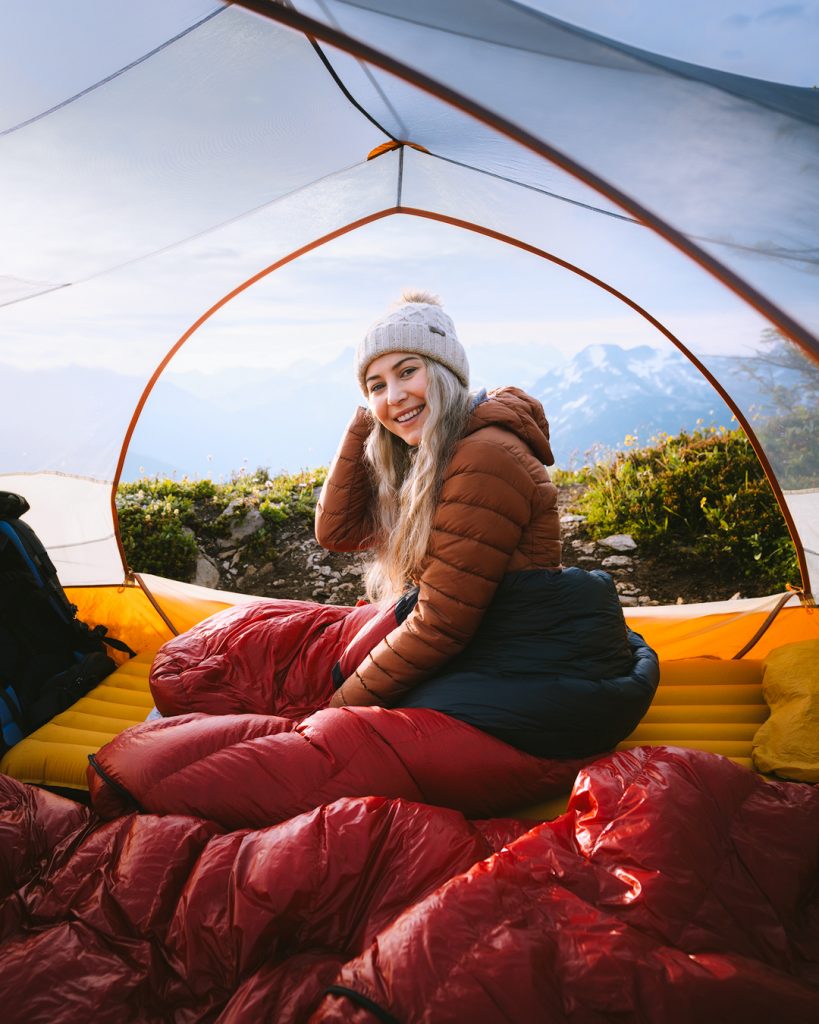
How To Plan a Backpacking Trip
I have an entire guide on how to prepare and plan for backpacking trips – check it out! One of the main things to consider is whether you will go backpacking solo or with other people.
Finding people to Go Backpacking With
If you are a complete beginner I would definitely suggest finding someone else to go with. Maybe a friend who has done it before or you could meet up with someone likeminded who is also wanting to try it out. There are tons of Facebook groups/pages for finding other outdoorsy women. Some I recommend checking out:
- Outdoorsy Gals
- The Wandering Queens
- Solo Female Hikers & Adventurers
- Women Who Hike
- Backpacking & Hiking Enthusiasts
- Plus Sized Hikers
- Washington Hikers and Climbers (specific to Washington State)
- PNW Hiker Babes (specific to the Pacific Northwest)
- PNW Outdoor Women (specific to the Pacific Northwest)
- Single Hikers of the PNW (specific to the Pacific Northwest)
If you would like to explore the option of going solo then I highly recommend you check out my blog post about my first time solo backpacking as a woman, including tons of solo tips!
How To Choose a backpacking Destination
Another major thing to consider is where you will go backpacking. I know a lot of women are concerned about safety when backpacking and don’t want to be completely alone in the wilderness. These are my top tips for choosing somewhere to go backpacking, especially your first time:
- Choose a relatively popular trail that is well marked, regularly maintained, and easy to follow. For example, national park trails and backpacking destinations closer to a city.
- Don’t go too deep into the backcountry for your first time and also choose a camping destination under 5 miles from the trailhead. Though keep in mind that you’re safer when camping more than 1 mile away from a road or trailhead, so choose a sweet spot somewhere in between those.
- If it’s a more quiet / lesser visited trail then you could consider going on a Friday or Saturday night, where the chances of others being around is higher.
- You could choose a destination that has phone service for some extra peace-of-mind.
Google will be your biggest help with finding trails. You can also check trail reports on AllTrails and if you’re based in Washington then I would recommend using trip reports and guides by the Washington Trails Association.
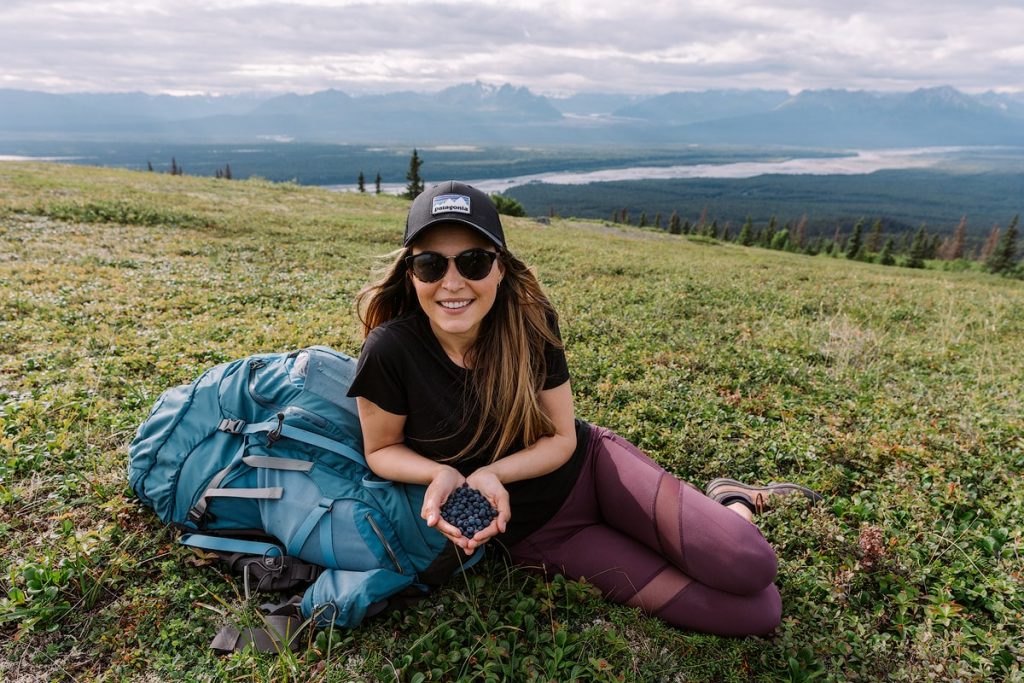
Female Backpacking Safety Tips
It seems that the two things that scare women the most when thinking about backpacking are wildlife and men. And when I say wildlife, I am mostly referring to bears.
I first want to say that the likelihood of something bad happening to you in the wilderness in relation to men and wildlife is very low, especially if you take adequate precautions. As a woman, you are statistically more safe in the backcountry compared to walking around a city after dark. But it is important that you’re prepared – let’s talk about how to do that.
How to stay safe when backpacking as a woman
- Hike with other people when possible. You can also bring your dog along if they are a good fit for backpacking.
- Pack adequate gear (including the 10 essentials) and know how to use it.
- Research trail conditions + weather and factor that in when preparing for your adventure.
- Carry an emergency / GPS device such as a Garmin InReach or Spot beacon.
- Consider carrying runner’s mace or bear spray. Some women also like to carry a knife for multi-purpose uses and also as a back-up weapon.
- Research wildlife in the area you are backpacking and follow bear precautions if necessary. Read my guide on bear safety for backpackers and hikers.
- Avoid camping on or near a game trail. You don’t want animals or hunters running into you.
- ALWAYS tell someone you trust exactly where you are going and when you will be back.
- Be careful who you talk to about your plans once you’re out on the trail. Consider keeping your camping destination to yourself and don’t point out the fact that you will be alone. Avoid answering or even lie if you feel uncomfortable.
- Don’t hesitate to use your safety whistle if the need arises – 3 blasts is the universal call for help.
And probably the most important thing to consider when backpacking as a woman – trust your gut! If you feel uneasy about someone be sure to distance yourself, keep information private, and potentially consider hiking back to your car. Confide in other female hikers if you feel unsafe. There is absolutely no shame in turning around if you feel unsafe or unprepared.
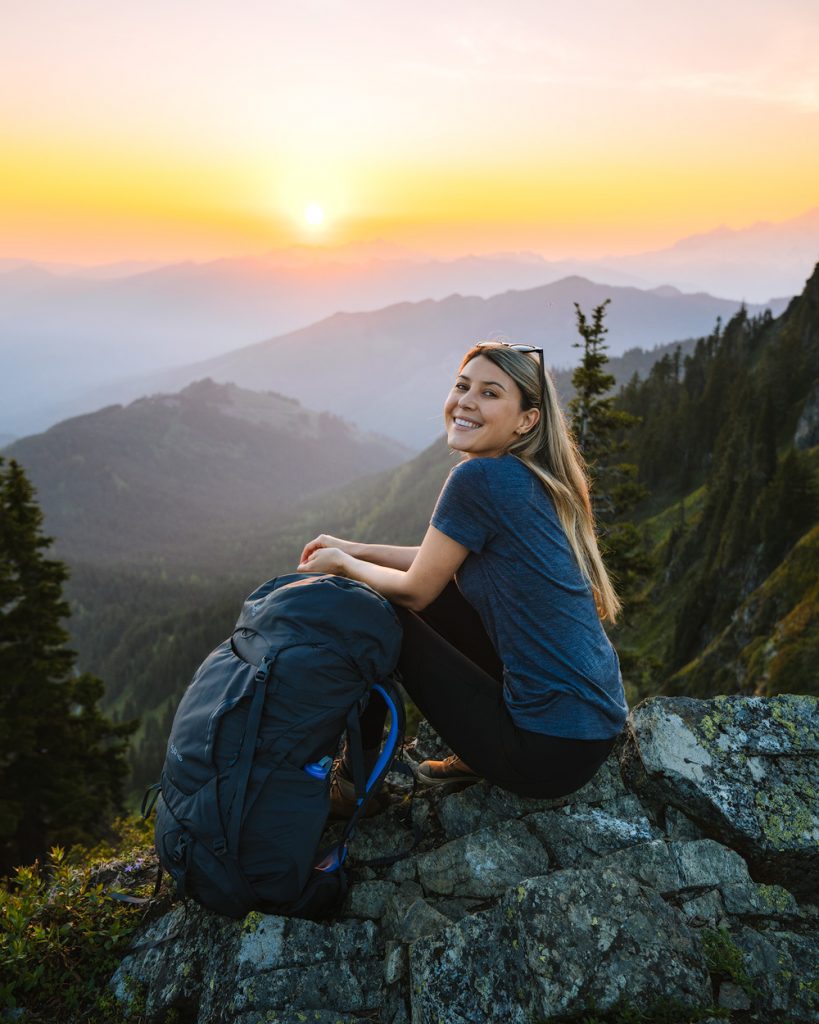
bACKPACKING WITH YOUR PERIOD
I won’t sugarcoat it… backpacking with your period kind of sucks haha. But it’s 100% possible and I have successfully done it numerous times, both for longer treks and overnight trips. The number one trick is to come prepared!
As people who menstruate, we have typically learned over time what products we like and what products we don’t. It’s also important that you stick with what you know how to use and what you find comfortable.
The Best Period Products For Backpacking
Having spoken to other women about this topic, researched online, and tried out the different options for myself, it seems that tampons are the most commonly used period product when backpacking. I think this is because they are a nice middle ground when it comes to comfort, mess, waste, and ease of use. You can also change a tampon without getting too messy and they aren’t bulky or hot to hike in. BUT you do need to pack out all of your used tampons and cannot bury them, thus adding weight and bulk to your pack.
Menstrual cups and discs are typically the most sustainable options for managing periods, though I do find them to be messier and more cumbersome in the backcountry. Washing your hands and cup is more challenging in the wilderness and then disposing of the contents can be a pain (you need to dig a hole to properly bury the blood like you would any human waste in the backcountry). A big plus side of using menstrual cups or discs is that you don’t need to pack out used tampons or pads.
Pads are another option but they can be bulky, hot, and uncomfortable to hike in. Like tampons, you will also need to pack out all your used pads as burying them is not an option from a Leave No Trace perspective.
Period underwear is similar to pads in that they can be bulky to hike in, but many women enjoy using them as a “back-up” option when on their period in the backcountry. You can buy them in bikini style, boyshorts, or thongs. My favorite brands are Thinx and Knix.
Other Period and Hygiene Items to Pack
I highly recommend making yourself a small backcountry hygiene kit. Use a lightweight zip pouch that is opaque, like this one. Inside my backcountry hygiene kit I keep the following:
- Prefered feminine hygiene products
- Small roll of backpacking toilet paper
- Lightweight trowel (for pooping or burying blood when using a cup/disc)
- Hand sanitizer and/or 1.3oz Sea To Summit Wilderness Wash
- Sea To Summit Wilderness Wipes (or Compressed Adventure Wipes)
- Zip baggie for packing out toilet paper, wipes, used period products etc.
- Pain medication if required
Some women like to pack a pee rag when backpacking, though I haven’t personally tried one out. A very popular option is Kula Cloth and I have heard Pacific Crest Trail thru-hikers rave about it! The idea behind using a pee rag is that it provides an alternative to the ‘drip-dry’ method or using toilet paper. Kula Cloths are reusable, antimicrobial, and have a positive impact on the environment due to less toilet paper waste being left in the backcountry.
Another great item to pack for day hikes or once-off backcountry bathroom breaks is an On-The-Go TP Kit. These are great because they come with toilet paper, wipes, and a sealable bag to pack everything out.
I store my sealed hygiene kit in my Ursack to protect from bears and critters, along with any other scented items and food.
How To Manage PerioD Pain in the backcountry
Cramps are no fun in the backcountry! I deal with them by using pain medications as necessary (e.g. Tylenol, Advil) and with heat. Sometimes I also use a stick-on heat pad like the Rael Natural Herbal Heating Patches or the Cora Heat Relief Patches. For cramps in the tent at night or when around camp, I will use a Nalgene leak-proof water bottle and fill it with hot water. It can slip inside your sleeping bag with you and will help so much!
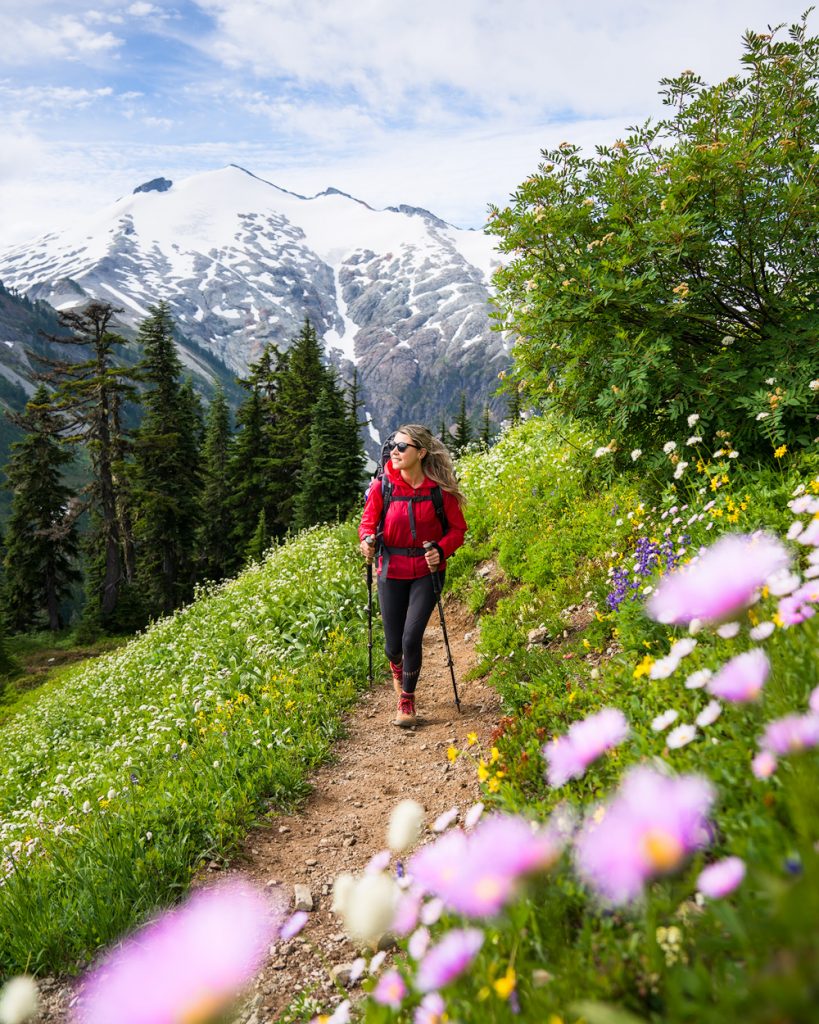
Mentally and Physically Preparing for Backpacking
Backpacking can be challenging, both mentally and physically. So I highly recommend you start an exercise plan to get fit for backpacking. Take shorter adventures and then work your way up to more challenging hikes. For specific information, I also recommend reading my in-depth guide to preparing for backpacking and hiking trips.
For a lot of women, it’s the fear of backpacking that holds them back. The fear of not being able to do it and the fear of being scared out there in the wilderness. It is best to be prepared physically and to take on a backpacking trip you feel confident completing, but there is zero shame in needing to turn around if you are struggling.
Read next: How To Get Over Your Fears of First Time Backcountry Camping
It’s also a possibility that you will get out into the wilderness and feel scared or worried. The number one thing to remember is to stay calm and reasonable. Take a deep breath, stop your thoughts from racing, and think through things logically. That rustle of your tent is most likely the wind and not a bear trying to get in with you.
I also recommend bringing a few calming distractions out into the backcountry. Maybe for you that’s an ebook (I LOVE my Kindle), a paperback book, some downloaded podcast episodes, or a journal. Some people even like to watch downloaded Netflix shows on their phone, just remember to pack a portable charger. And whatever you do… DO NOT WATCH OR LISTEN TO MURDER MYSTERIES! That is a recipe for being super on edge.
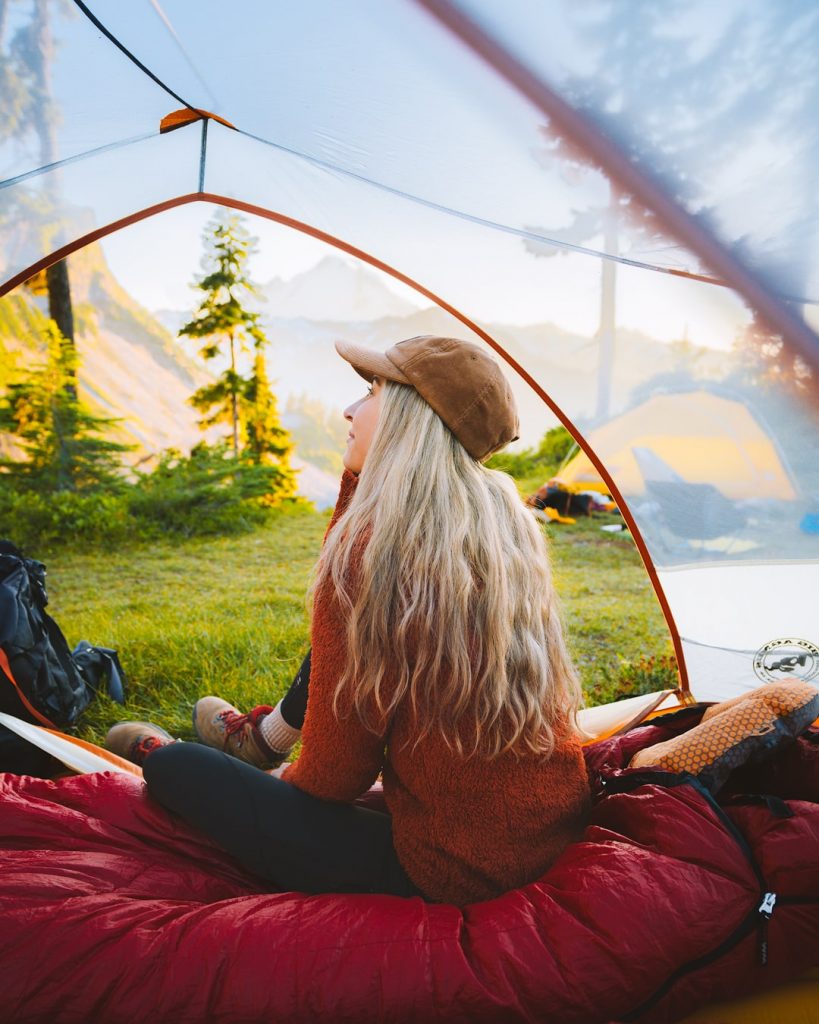
makE sure you have everything that you need
It is important to have everything you need before you hit the trail. You will find an entire backpacking checklist in the next section of this guide, but the most important things to remember are the 10 essentials.
WHAT ARE THE 10 ESSENTIALS?
1. NAVIGATION
Specifically, a paper map, compass, and/or GPS system. You will use your navigation system to help plan your trip/route, as well as to stay on track during your hike. Be sure to know how to read a topographic map and use a compass before needing to rely on one!
2. SUN PROTECTION
Specifically, sunscreen, sunglasses, and a hat. These items will protect you from harsh UV rays that can lead to sunburn and skin cancer. I always wear a sun hat when hiking (let’s make wide brim hats cool again!) and would also recommend wearing long sleeves if you are particularly prone to sunburn.
3. INSULATION LAYERS
Specifically, a jacket, hat/beanie, gloves, rain gear, thermal underwear/base layers. These will depend on the type of weather and season you are hiking in, but always be prepared for sudden changes in conditions. The NPS recommends you pack an extra layer of clothing that reflects the most extreme conditions you could encounter.
4. ILLUMINATION
Specifically, a headlamp, lantern, or flashlight. You will need some sort of light source for night hiking, around camp, and in case you get lost. Be sure to pack extra batteries if your device is battery-operated.
5. FIRST AID SUPPLIES
Specifically, a lightweight backpacking-friendly first aid kit. Be prepared for emergencies and also have a mini first aid kit with you on all hikes and backpacking trips. I personally bought a pre-made kit and then added a few extra items that were specific to my needs and the type of trip.
6. FIRE STARTER
Specifically, matches, a lighter, and/or fire starters. This is in regards to emergency settings where you may need to use fire as a signal, to keep warm, or to cook food. Otherwise, I recommend using a camp stove and avoiding open fires (always make sure to adhere to burn bans).
7. REPAIR KIT AND TOOLS
Specifically, duct tape, a knife, scissors, and/or a multi-tool. Having some basic repair items will help if a gear item breaks or in other emergency situations. Bring any tools/repair items specific to your trip.
8. SHELTER
Specifically, a tent, space blanket, tarp, or bivy. Adequate shelter will help protect you from severe weather conditions and exposure during an emergency survival situation.
9. FOOD
Specifically, meals and snacks for in between. Make sure you have enough food for your trip length, plus a little extra (e.g. a day’s extra supply). Think about the calorie density to weight ratio and also avoid heavy food items that will weigh down your pack.
10. HYDRATIOn
Specifically, water and a water filtration method. Remember to drink water often and before you feel thirsty. I also recommend using electrolytes when sweating (Ultima Lemonade and Liquid IV are my favorites). Water filtration is another consideration as it is best to avoid drinking unfiltered water. My go-to water filter is the Katadyn BeFree 1L Water Filter Bottle.
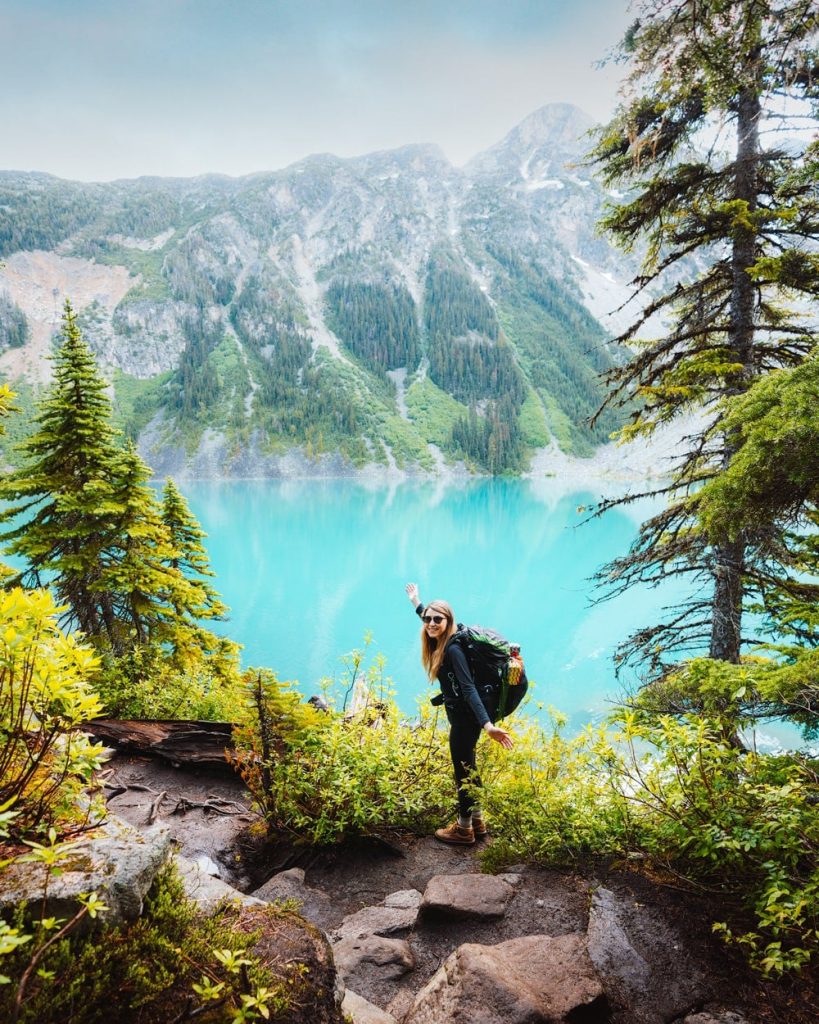
Leaving No TRace
Leaving a trail is a big no-no when backpacking. Following the 7 Leave No Trace principles will help you leave somewhere better than you found it. I will outline these principles below and you can also read my in-depth Leave No Trace guide for more information. I also recommend reading up on proper hiking trail etiquette and how to use the bathroom outdoors.
How To LEAVE NO TRACE
- Know the regulations and special concerns for the area you are visiting.
- Travel and camp on established trails and durable surfaces.
- Pack it in, pack it out (do not leave any trash int the backcountry).
- Deposit solid human waste in catholes dug 6 to 8 inches deep, at least 200 feet from water, camp and trails.
- Pack out toilet paper and hygiene products.
- To wash yourself or your dishes, carry water 200 feet away from streams or lakes and use small amounts of biodegradable soap. Scatter strained dishwater.
- Examine, but do not touch cultural or historic structures and artifacts.
- Leave rocks, plants and other natural objects as you find them.
- Where fires are permitted, use established fire rings, fire pans, or mound fires.
- Keep fires small. Only use sticks from the ground that can be broken by hand.
- Burn all wood and coals to ash, put out campfires completely, then scatter cool ashes.
- Control pets at all times, or leave them at home.
- Respect other visitors and protect the quality of their experience.
- Be courteous. Yield to other users on the trail.
- Observe wildlife from a distance. Do not follow or approach them.
- Never feed animals.
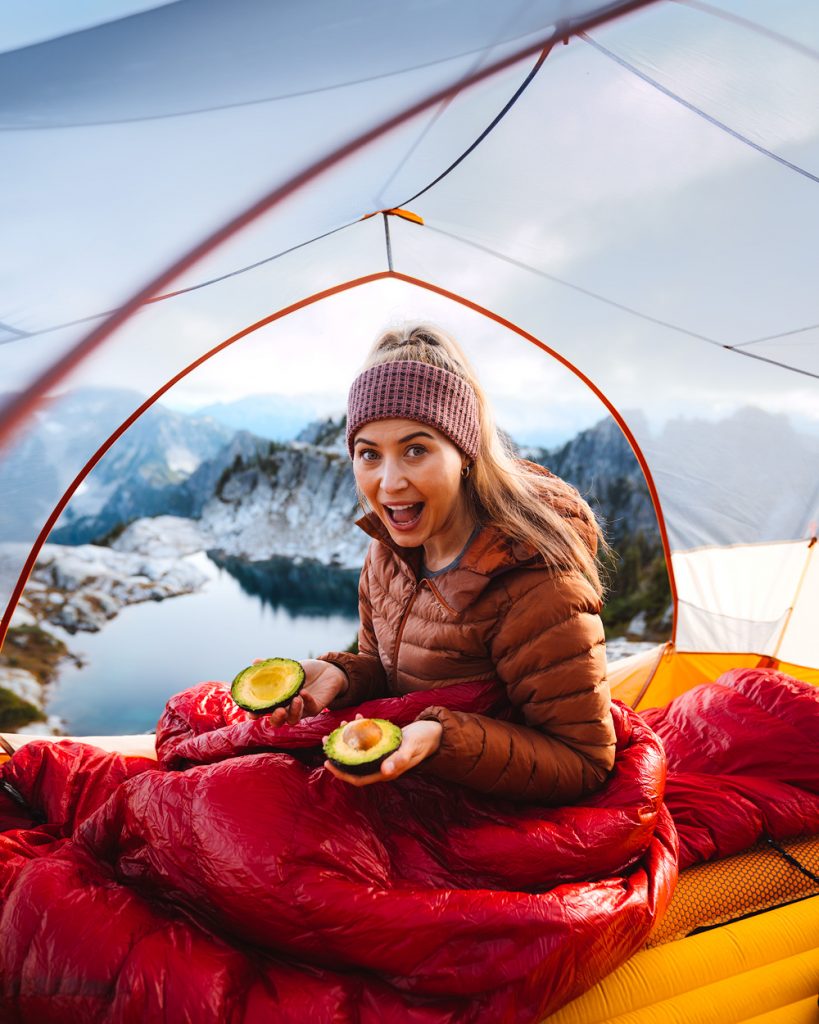
Female Backpacking List
I also have a blog post on what to pack for a backpacking trip, be sure to give that a read! I’ve also listed the key items below, which you can download as a printable backpacking checklist here! Note that my suggestions are for women and for three-season/summer camping. Information about what to wear when backpacking and hiking is listed in the next section. If you want to know more about winter backpacking then be sure to check out my winter-specific guide to hiking and backcountry camping.
BACKPACKING Gear Checklist
- Backpack + pack cover. Suggested > Osprey Lumina 60L Pack or Osprey Kyte 46L Pack + Osprey Ultralight Backpack Rain Cover
- Tent / shelter. Suggested > Big Agnes Tiger Wall UL2 or Stoic Driftwood 2P Tent (more affordable)
- Sleeping bag. Suggested > Big Agnes Torchlight UL 30F Down Sleeping Bag
- Sleeping pad. Suggested > Exped SynMat UL or Sea To Summit Ether Light XT (for side sleepers)
- Inflatable pillow. Suggested > Exped Air Pillow or Sea To Summit Aeros Ultralight Pillow
- Head Lamp + batteries. Suggested > Petzl Actik Core Headlamp
- Navigation. Suggested > Brunton TruArc 5 Compass + NRS Hydrolock Mapcessory Map Case + paper map
- First aid kit. Suggested > Adventure Medical Ultralight & Watertight Series Medical Kit
- Knife / multi-tool. Suggested > Leatherman Bond Multi-Tool, Trango Barracuda Knife
- Repair kit. Suggested > Therm-a-Rest Instant Field Repair Kit, Hyperlite Mountain Gear Dyneema Fabric Repair Kit, duct tape, etc.
- Baselayer bottoms. Suggested > Icebreaker 150 Zone Women’s Leggings
- Baselayer top. Suggested > Icebreaker 150 Zone Women’s Long-Sleeve Crewe Top
- Mid layer top (fleece). Suggested > Patagonia Women’s Micro D 1/4-Zip Fleece Pullover
- Insulated layer (puffy). Suggested > Patagonia Women’s Nano Puff Hooded Insulated Jacket or Arc’teryx Cerium LT Down Jacket
- Rain jacket. Suggested > Marmot Women’s PreCip Eco Jacket or Arc’teryx Zeta SL Rain Jacket
- Spare pair of socks. Suggested > Darn Tough Women’s Hiker Coolmax Micro Crew Cushion Socks
- Meals + snacks. I’m a big fan of ProBar BOLT Chews and Mary Janes Farm dehydrated meals
- Water bladder / bottle. Suggested > Osprey Packs Hydraulics LT Hydration Reservoir, Katadyn BeFree 1L Water Filter Bottle
- Water filter. Suggested > Katadyn BeFree 1L Water Filter Bottle
- Lightweight camping stove. Suggested > Jetboil MiniMo Stove
- Gas canister. Suggested > Jetboil JetPower Fuel
- Lighter / matches. Suggested > BIC mini lighter
- Spork. Suggested > Sea to Summit Alpha Light Long Spork
- Mug. Suggested > Sea To Summit X Mug Cool Grip
- Trowel. Suggested > Sea To Summit Pocket Trowel or the Deuce Ultralight Backpacking Trowel
- Toilet paper + sealable bag for packing out. Suggested > TP Kits, Coghlan’s Packable Camp Toilet Tissue
- Body / face wipes. Suggested > Sea To Summit Wilderness Wipes (or Compressed Adventure Wipes)
- Hand sanitizer. Suggested > Purell Gel Hand Sanitizer
- Period products
- Toothbrush + paste
- Sunscreen
- Lip balm
- Bug spray
- Phone / camera
- ID, debit card, cash
- Trail permit if required
OTHER BACKPACKING ITEMS YOU MAY WANT TO CONSIDER:
- Rain pants. Suggested > Outdoor Research Women’s Helium Rain Pants
- Beanie. Suggested > Fjallraven Byron Thin Hat
- Gloves. Suggested > Icebreaker Sierra Glove
- Stuff sacks. Suggested > Sea To Summit Ultra-Sil 1-35L Dry Sacks
- Trekking poles. Suggested > Black Diamond Alpine Carbon Cork Trekking Poles
- Bear spray. Suggested > Counter Assault Bear Spray + Holster
- Bear canister. Suggested > Bear Vault BV450 Solo Bear Resistant Food Canister or Ursack
- Wind jacket. Suggested > Outdoor Research Women’s Helium Wind Hooded Jacket
- Bug head net. Suggested > Even Naturals Mosquitos Head Net
- Small lantern. Suggested > Lander Cairn Mini Lantern
- Camp sandals. Suggested > Xero Shoes Z-Trail EV Women’s Sandals
- Swimsuit. Suggested > Women’s swimsuits
- Mini towel. Suggested > Packtowl Original Towel
- Body/hand wash. Suggested > 1.3oz Sea To Summit Wilderness Wash
- Pee rag. Suggested > Kula Cloth
WHAT TO WEAR BACKPACKING As a Woman
Below are the items I would recommend you wear on your body when hiking or backpacking. You will obviously need to tailor this list to suit the type of trip, weather conditions, etc. For example, in colder weather, you may wear your fleece or a wind jacket (featured in the section above).
- Hiking boots. Suggested > Danner Mountain 600 Hiking Boots. Check out my guide on the best hiking shoes.
- Hiking bottoms. Suggested > Patagonia Quandary Short, Arc’teryx Gamma LT Pant, Backcountry Green Mountain Trail Legging
- Moisture wicking shirt. Suggested > Icebreaker Tech Lite SS Low Crewe Shirt, Icebreaker Sphere LS Low Crewe Shirt (longsleeve)
- Merino wool socks. Suggested > Smartwool Hike Light Crew Sock, Smartwool PhD Outdoor Light Micro Sock
- Quick-dry underwear. Suggested > Icebreaker Sprite Racerback Bra, Icebreaker Siren Thong, Smartwool Seamless Bikini Underwear
- Sun hat. Suggested > Patagonia P-6 Label Trad Cap, Columbia Bora Bora Booney II Hat
- Sunglasses. Suggested > Smith Shoutout Chromapop Polarized Sunglasses, Goodr Circle G’s Polarized Sunglasses.
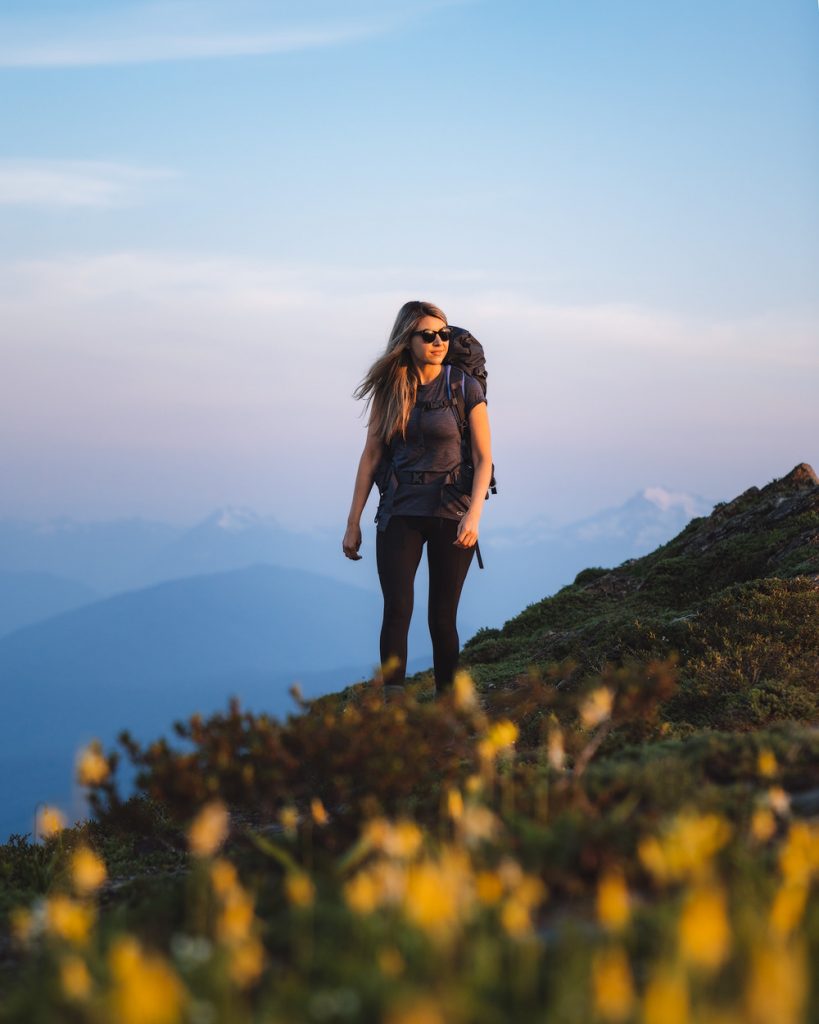
MORE BACKPACKING and Hiking RESOURCES
I hope you found this guide helpful! If you’re looking for more backpacking hiking tips then definitely check out some of our other articles:
- Beginners Guide to Hiking (including a packing checklist)
- 9 Backpacking Mistakes to Avoid When Starting Out
- The Best Hiking Shoes for Men and Women
- What To Wear Hiking as a Woman
- Best Apps for Planning and Recording Hikes
- Hiking Trail Etiquette Rules You Need To Know
- Leave No Trace Principles and How To Follow Them
- Eco-Friendly Outdoor Hygiene for Hikers and Campers
- Must-Know Bear Safety Tips for Hiking and Camping
- How To Get Over Your Fears of First Time Backpacking
- Tips for First Time Solo Backpacking as a Woman
- How To Prepare for Hiking and Backpacking Trips
- Beginners Guide to Backpacking (including a printable checklist)
- How To Get a Good Nights Sleep in the Backcountry
- Beginners Guide to Winter Hiking and Camping
PIN for Later
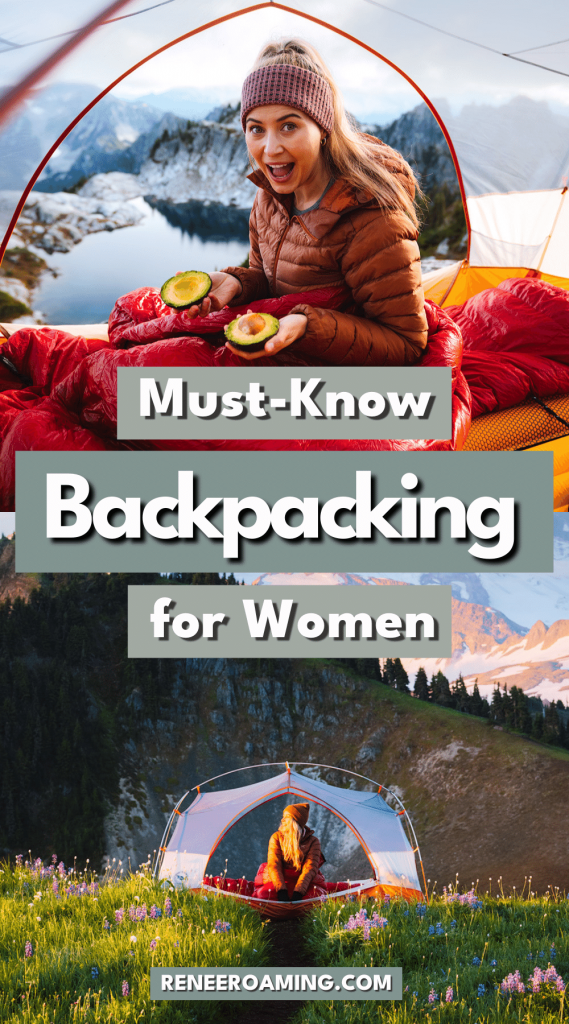
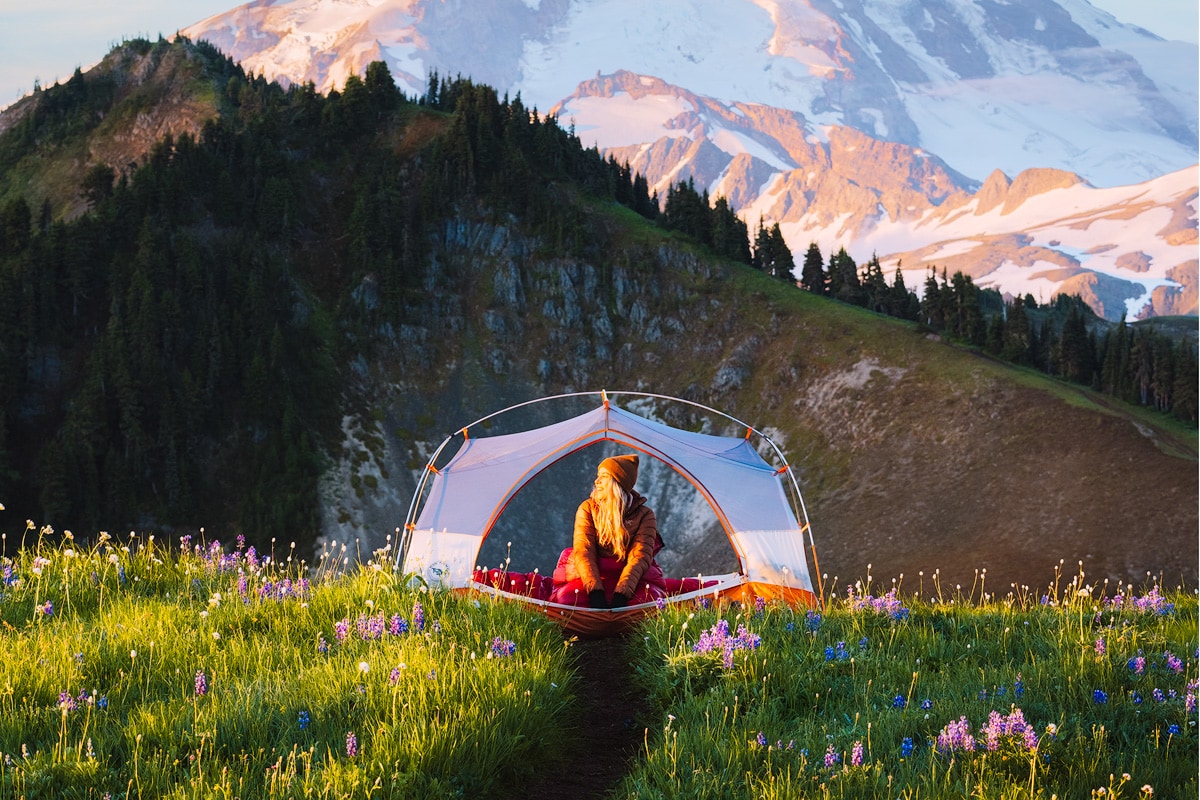
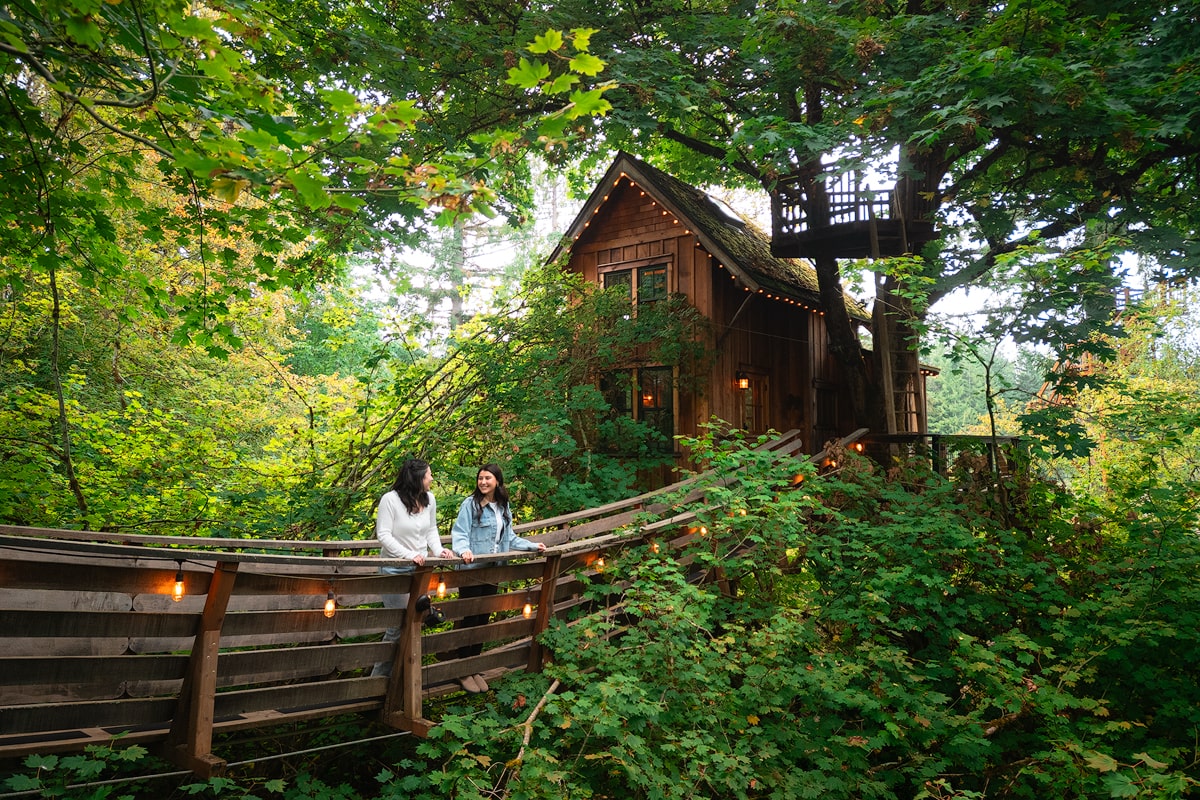
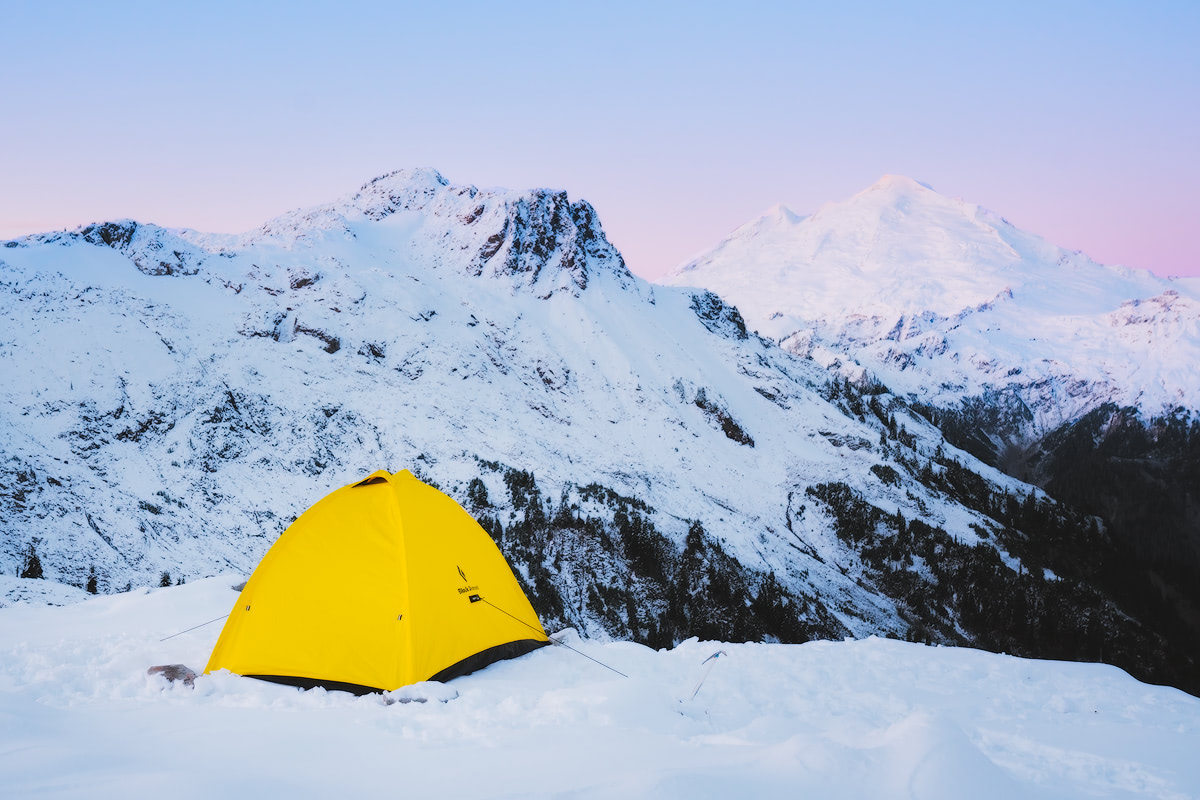
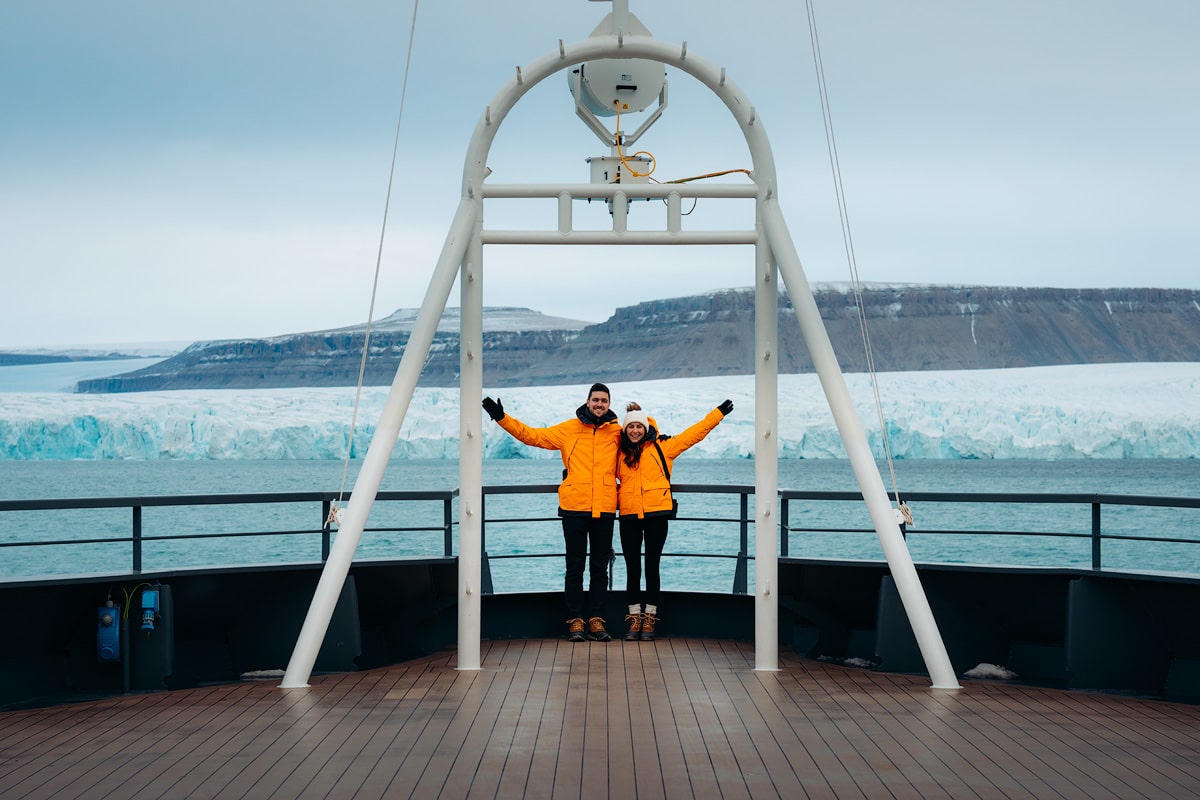
This is a great resource for women who want to try backpacking! I especially appreciate the tips on finding hiking buddies. It’s kinda like finding teammates for UMA Racing Roblox Game! Can’t wait to share with my friends!
VoidStrap is a sleek and modern Roblox bootstrapper designed for speed and stability. It delivers faster launch times, smooth updates, and an overall improved gameplay experience. With its advanced customization options, users can tailor everything to their preferences. VoidStrap is perfect for players who value performance, control, and a clean, modern interface.
I love how empowering the article starts—backpacking indeed proves that women can conquer physical and mental challenges in the wild.
Such a helpful guide! I love how practical and empowering these tips are—definitely bookmarking this for my next trip. Thanks for sharing your experience!
Backpacking solo taught me the importance of smart packing, choosing safe accommodations, and trusting my instincts. I always carry essentials like a portable charger, a water filter, and quick-dry clothing. Researching local customs ahead of time helps me blend in and feel more confident while exploring unfamiliar destinations as a woman.
Matches are fast-paced, typically lasting around 3 minutes, so you can jump in and enjoy quick, action-packed gameplay.
There are fruit items that appear for extra points – Sometimes, fruits like cherries, strawberries, or apples appear in the maze. If Pac-Man eats them, you receive bonus points. These fruits add another layer of challenge as you try to grab them while avoiding the ghosts.
It can slip inside your sleeping bag with you and will help so much!
Your amazing!
Excellent resource! And I appreciate the discount coupon.
I like your tips! Thanks for sharing. The main thing is not to go overboard with the weight: it should not exceed 25 percent of your own. Most often, backpacking is associated with budget travel, but, in fact, backpacking is not only and not so much thrifty travel, it is a whole subculture of free travel with its own attributes, ideology and principles.
I’m definitely struggling with packing! I’m 5’1 and weigh under 100 pounds which sucks.